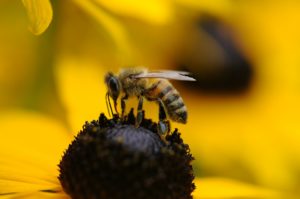
For the untrained eye, it can be quite easy to accidentally mistake the two for each other. And you can’t really blame people for making that mistake, when certain wasps and bees are practically indistinguishable in color from a far. However, once you start approaching, you’ll be able to tell subtle differences that the two insects have with each other, from the colors to the size, and if you actually place them side-by-side, you would more than likely be able to separate the two insects from one another.
But why would you approach a bee or wasp in the first place?
Bee and Wasp similarities?
Before delving into their differences, we can look at the traits that bees and wasps shares.
Obviously, both insects can fly. They are also equipped with stingers that they use to deter predators or other threats from approaching them. Bees and wasps belong in the same order of insects, Hymenoptera, and the two buzzing insects are pollinators as well.
As for their body structure and color, again, they look similar, but only when seen from afar. This will be discussed in more detail later on.
Bee and Wasp Differences?
When comparing and contrasting the similarities and differences between animals, physical structure and appearance isn’t everything. Just because an insect can fly, is colored yellow with black stripes, and wants to sting you, doesn’t mean that it is automatically a wasp. It also doesn’t mean it’s automatically a bee either.
Obviously when you’re being chased and in danger of being stung, you don’t have time to think about the subtle differences, because you’re busy running away and making sure you don’t get stung.
But when one wants to be able to tell the difference between the two, they must also be able to look beyond physical appearances. For instance, one must take a look at things like their aggressiveness as well as their preferred food.
Here are a couple of factors where bees and wasps differ.
Aggressiveness
One of the most notable things that people take note of when differentiating the two species is how aggressive they are. After all, you want to know which one of these is more likely to want you dead, and which one will probably leave you alone if you leave it alone.
Both bees and wasps are similar in the sense that they aren’t really looking for a fight, at least not on purpose. Rather, they get aggressive when they believe that they or their colonies are in danger, and thus, retaliate as a result.
But in terms of range, while both get considerably aggressive when you so much as approach their hive, a wasp is much easier to provoke than a bee and will chase you farther than a bee usually would in an attempt to sting you. Bees usually only chase you around 45 meters, while a wasp can go somewhere between 50-100 meters. The exception here, however, is the Africanized bee, which can chase people three times as far as a regular bee would.
Sting potency
There are several factors to consider in terms of sting potency. First, we’ll talk about how many times bees and wasps can sting.
As mentioned earlier, bees and wasps both have stingers that they use to defend themselves against threats. Depending on the bee species, the stinger can either only be used once or it can be used multiple times.
To be more specific, a honeybee’s stinger is more or less “single use”. This is because these bees can only make one “deep” sting before they die. due to the fact that their stingers are barbed, meaning that the stinger is more likely to stay attached on its target the deeper it is pushed in. If a honeybee forcefully tries to remove itself from its target after stinging, it will more than likely disembowel itself and end up dying not long after.
In comparison, wasps regularly use their stingers while attacking. In fact, they use these stingers to sting and kill prey, and they are able to sting multiple times without the same risk that a honeybee has when stinging. This is because wasp stingers are much smoother, and thus able to slip out of their targets easily.
In single stings, bee venom is much more potent, being able to inflict as much as 50 micrograms of venom. In comparison, wasps only really inject around between 2 to 15 micrograms of venom. However, the wasp can sting multiple times, and if allowed to do so, will easily overwhelm a single bee in terms of venom volume.
Bodily structure
Looking at how bees and wasps are built, their coloring and sizes are similar until viewed up close.
Bees have a rounded body structure, and are also quite hairy. This allows them to carry as much pollen as possible. Their legs are flat, white, and hairy.
In comparison, wasps have a more narrow body shape, which is slender and smooth. Their legs are smooth, round, and waxy.
Preferred food
Bees feed exclusively on nectar from flowers, thus making them vegetarians. They also eat the honey that the make inside their hives, which is why taking too much honey from a beehive might cause its inhabitants to starve.
Wasps are a mix, as they are predators but also pollinators. This means that they will kill and consume insects like flies and caterpillars but will also consume nectar the same way bees do.
Bottom line
Wasps aren’t exactly one of the more popular insects. In fact, many people despise them for being essentially the more aggressive versions of bees, but they’re not all bad.
As mentioned above, wasps are still pollinators, but they also provide the benefits of being a predator of insects, meaning that they are also quite helpful when dealing with pests.
Despite similar-looking physical appearances, examining them in closer detail shows us that wasps and bees are most definitely different in how they go about their lives.
